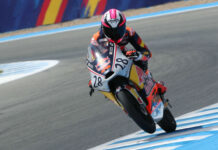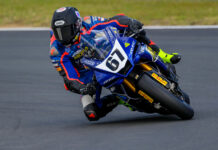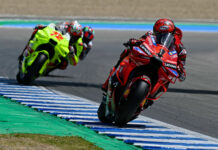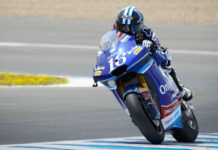FIRST PERSON/OPINION By David Swarts In January, AMA Pro Racing announced that it will implement a hardware price cap of $18,000 per motorcycle for engine control and data acquisition electronics in the Superbike class, beginning with the 2013 season and continuing through 2015. The only previous restriction required that hardware be homologated and approved for use by AMA Pro Racing Technical Director Of Competition Al Ludington. But teams say that hardware cost is not the biggest concern, with the cost of buying or developing software and hiring qualified technicians to run the complicated systems making up the bulk of the expense. Yoshimura Racing admits to spending $300,000 per season on electronics hardware, software, development, testing and personnel for its two-rider effort in AMA Pro Superbike. Yoshimura uses Magneti Marelli Marvel 4 systems and employs multiple technicians to run the systems. Monster Energy Graves Yamaha also runs Magneti Marelli Marvel 4 systems on its Superbikes and employs multiple technicians, but says one technician is assigned to run the Magneti Marelli SRT systems on its Daytona SportBikes. Jordan Suzuki and National Guard Suzuki use Pectel systems run by multiple technicians, while KTM uses Magneti Marelli SRT systems run by a technician who flies in from Italy for each AMA Pro Superbike round. Most of the other teams use much-less-expensive, much-less-capable, readily available race-kit black boxes (a.k.a. Engine Control Units, or ECUs) that sell for less than $3500 including wiring harness. Examples include Suzuki’s EM Pro system for GSX-R1000s and Yamaha’s YEC system for YZF-R1s. The BMW kit box for the S1000RR sells for about $4000 and plugs into the standard wiring harness. The Kawasaki kit box and wiring harness for the ZX-10R sell for less than $1500. A KTM kit box and setting tool for the RC8 R sells for under $1200. An EBR kit box for the 1190RS sells for $750. Meetings held as recently as last month between AMA Pro Racing officials and team representatives have revealed a deep divide in the paddock, with the majority of teams wanting to switch to kit boxes across the board, with a few notable holdouts. AMA Pro officials have openly admitted that they established the 2013-2015 rule now on the books based on one winning team’s threat to quit the series if it wasn’t allowed to continue using the Marvel 4 system currently fitted to its racebikes. To check where the top-10 players in the AMA Pro Superbike class stand on electronics rules, we posed the following questions: 1. What should the AMA Pro Superbike electronic rules be for 2013-2015 and why? 2. What do you say to someone who claims they need a year or more notice to get ready for any rule change, including switching from the currently allowed advanced electronics to kit boxes? Part Eight: Jason Farrell, Owner/Rider Farrell Performance Electronics, Kawasaki Race Kit “That’s a hard one. I’ve gone back and forth. I’ve thought about it from so many different ways. Superbike should be Superbike. I always think of Superbike how it was years ago in the early 2000s and before DMG took it over. To me it is the premier class and that’s how things change and get better, by trying to make the bikes handle better with the electronics. “But to be honest with you, my Kawasaki race kit black box, and I’m one of the only guys who can speak for it, works really well. I’ve got a year riding and tuning it. It has traction control, wheelie control, launch control and engine braking control, and it’s pretty versatile to where I can get the bike to work pretty decent. And I don’t only race the [AMA Superbike] series. So from racing the [Michelin Pro/ASRA] endurance stuff we’ve been able to tune it to where the tires last longer and stuff like that. “Do you remember [1000cc] Superstock. I’m racing a Superstock bike against these [Superbike] guys. I got stock wheels, stock brakes – a Brembo master cylinder with stock rotors and calipers. It’s definitely hindering me running that bike in Superbike. If they had a Superstock class I would be running both classes, like we used to, but this is Superbike now. “I’ve read all the parts of your articles on this. I’ve seen the opinions go in both directions. I’ve seen the guys say we need to go with kit electronics, and some guys are saying keep it stock with no traction control at all. It’s hard. “I’ve been able to turn almost the same lap times with traction control turned on and traction control turned off. It makes it so I can last longer in the race because I don’t have to focus so hard thanks to the wheelie control coming out of the corners. When you don’t have traction control you really have to keep your mental focus. You can still turn the fast lap times without it, but you make less mistakes with traction control. And there are times when you don’t want traction control and you want to spin it up a bit more, and that’s where they’re [larger AMA Superbike teams] paying these technical guys to come in and tune the electronics for that in different sections of the track. And yeah, I can say that’s where they’re going to have an advantage over a guy like myself and do better. And the engine braking control seems to be the next big thing where everyone’s going more than traction control. They’re working on the engine braking control and keeping the bike smoother going into the corners. That’s where they’re getting away from me a little bit. “I guess I like the kit black box idea. They need to have these certain options [capabilities] on it and then put a price cap on it. In the position I’m in as a privateer I say yeah, let’s keep it to kit black boxes like what I have. And you can see the results I’ve put in with a kit black box [sixth in Superbike Race One at Road America]. It’s not like you need all of this crazy stuff. Yeah, Josh Hayes was three seconds a lap faster than me at Road America. Was part of that me having a three-person crew working out of a pick-up truck and trailer? Yeah. But Josh Hayes is a damn good rider, and my ability needs to go up a bit. Let’s just say if I could go to Road America with a crew capable of working on the bike better, I think I could go 1.5 seconds faster there. So where is that other 1.5 seconds? Maybe it’s in the bike, like in wheels and brakes. So I don’t think [advanced electronics] are giving him a huge advantage.” If someone said they needed a year or more to prepare for a change in the electronics rules like you are suggesting, what would you say to them? “I don’t think so. I don’t think it takes that long. You can figure out a kit black box in short order. It doesn’t take that long. It’s fairly simple to go figure this stuff out. Those other Marelli and MoTec boxes take way longer to learn versus a kit box. There’s so much more going on with those, but race kit black boxes come with a baseline programmed in from the factory.” To be continued…
© , Roadracing World Publishing, Inc.





